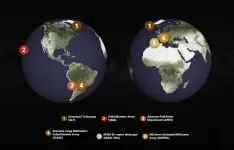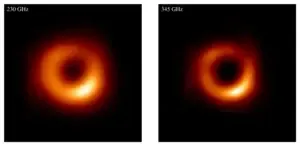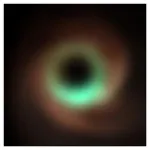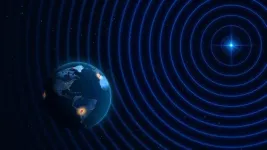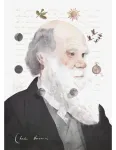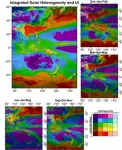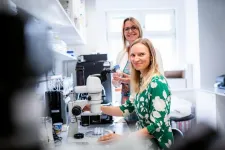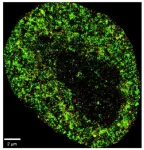(Press-News.org) The Event Horizon Telescope (EHT) Collaboration has conducted test observations achieving the highest resolution ever obtained from the surface of the Earth, by detecting light from the centers of distant galaxies at a frequency of around 345 GHz.
When combined with existing images of supermassive black holes at the hearts of M87 and Sgr A at the lower frequency of 230 GHz, these new results will not only make black hole photographs 50% crisper but also produce multi-color views of the region immediately outside the boundary of these cosmic beasts.
The new detections, led by scientists from the Center for Astrophysics | Harvard & Smithsonian (CfA) that includes the Smithsonian Astrophysical Observatory (SAO), were published today in The Astronomical Journal.
“With the EHT, we saw the first images of black holes by detecting radio waves at 230 GHz, but the bright ring we saw, formed by light bending in the black hole’s gravity still looked blurry because we were at the absolute limits of how sharp we could make the images,” said paper co-lead Alexander Raymond, previously a postdoctoral scholar at the CfA, and now at NASA’s Jet Propulsion Laboratory (NASA-JPL). “At 345 GHz, our images will be sharper and more detailed, which in turn will likely reveal new properties, both those that were previously predicted and maybe some that weren’t.”
The EHT creates a virtual Earth-sized telescope by linking together multiple radio dishes across the globe, using a technique called very-long-baseline interferometry (VLBI). To get higher-resolution images, astronomers have two options: increase the distance between radio dishes or observe at a higher frequency. Since the EHT was already the size of our planet, increasing the resolution of ground-based observations required expanding its frequency range, and that’s what the EHT Collaboration has now done.
”To understand why this is a breakthrough, consider the burst of extra detail you get when going from black and white photos to color,” said paper co-lead Sheperd “Shep” Doeleman, an astrophysicist at the CfA and SAO, and Founding Director of the EHT. “This new ‘color vision’ allows us to tease apart the effects of Einstein’s gravity from the hot gas and magnetic fields that feed the black holes and launch powerful jets that stream over galactic distances.”
A prism splits white light into a rainbow of colors because different wavelengths of light travel at different speeds through glass. But gravity bends all light similarly, so Einstein predicts that the size of the rings seen by the EHT should be similar at both 230 GHz and 345 GHz, while the hot gas swirling around the black holes will look different at these two frequencies.
This is the first time the VLBI technique has been successfully used at a frequency of 345 GHz. While the ability to observe the night sky with single telescopes at 345 GHz existed before, using the VLBI technique at this frequency has long presented challenges that took time and technological advances to overcome. Water vapor in the atmosphere absorbs waves at 345 GHz much more than at 230 GHz weakening the signals from black holes at the higher frequency. The key was to improve the sensitivity of the EHT, which the researchers did by increasing the bandwidth of the instrumentation and waiting for good weather at all sites.
The new experiment used two small subarrays of the EHT—made up of the Atacama Large Millimeter/submillimeter Array (ALMA) and the Atacama Pathfinder EXperiment (APEX) in Chile, the IRAM 30-meter telescope in Spain, the NOrthern Extended Millimeter Array (NOEMA) in France, the Submillimeter Array (SMA) on Maunakea in Hawaiʻi, and the Greenland Telescope—to make measurements with resolution as fine as 19 microarcseconds.
“The most powerful observing locations on Earth exist at high altitudes, where atmospheric transparency and stability is optimal but weather can be more dramatic,” said Nimesh Patel, an astrophysicist at the CfA and SAO, and a project engineer at SMA, adding that at the SMA, the new observations required braving icy roads at Maunakea to open the array in the stable weather after a snow storm with minutes to spare. “Now, with high-bandwidth systems that process and capture wider swaths of the radio spectrum, we are starting to overcome basic problems in sensitivity, like weather. The time is right, as the new detections prove, to advance to 345 GHz.”
This achievement also provides another stepping stone on the path to creating high-fidelity movies of the event horizon environment surrounding black holes, which will rely on upgrades to the existing global array. The planned next-generation EHT (ngEHT) project will add new antennas to the EHT in optimized geographical locations and enhance existing stations by upgrading them all to work at multiple frequencies between 100 GHz and 345 GHz at the same time. As a result of these and other upgrades, the global array is expected to increase the amount of sharp, clear data EHT has for imaging by a factor of 10, enabling scientists to not only produce more detailed and sensitive images but also movies starring these violent cosmic beasts.
“The EHT's successful observation at 345 GHz is a major scientific milestone,” said Lisa Kewley, Director of CfA and SAO. “By pushing the limits of resolution, we’re achieving the unprecedented clarity in the imaging of black holes we promised early on, and setting new and higher standards for the capability of ground-based astrophysical research.”
Resource
“First Very Long Baseline Interferometry Detections at 870 μm,” A.W. Raymond, S. Doeleman, et al (2024), The Astronomical Journal, DOI: 10.3847/1538-3881/ad5bdb
About the Center for Astrophysics | Harvard & Smithsonian
The Center for Astrophysics | Harvard & Smithsonian, which includes the Smithsonian Astrophysical Observatory, is a collaboration between Harvard and the Smithsonian designed to ask—and ultimately answer—humanity's greatest unresolved questions about the nature of the universe. The Center for Astrophysics is headquartered in Cambridge, MA, with research facilities across the U.S. and around the world.
About the Submillimeter Array (SMA)
The Submillimeter Array is a joint project of the Smithsonian Astrophysical Observatory and the Academia Sinica Institute of Astronomy and Astrophysics. We acknowledge the significance that Maunakea, where the SMA is located, has for the indigenous Hawaiian people.
About the Greenland Telescope
The Greenland Telescope is a joint project of the Smithsonian Astrophysical Observatory and the Academica Sinica Institute of Astronomy and Astrophysics.
About EHT
The EHT Collaboration involves more than 400 researchers from Africa, Asia, Europe, North and South America, with around 270 participating in this paper. The international collaboration aims to capture the most detailed black hole images ever obtained by creating a virtual Earth-sized telescope. Supported by considerable international efforts, the EHT links existing telescopes using novel techniques—creating a fundamentally new instrument with the highest angular resolving power that has yet been achieved.
The EHT consortium consists of 13 stakeholder institutes; the Academia Sinica Institute of Astronomy and Astrophysics, the University of Arizona, the Center for Astrophysics | Harvard & Smithsonian including the Smithsonian Astrophysical Observatory, the University of Chicago, the East Asian Observatory, Goethe University Frankfurt, Institut de Radioastronomie Millimétrique, Large Millimeter Telescope, Max Planck Institute for Radio Astronomy, MIT Haystack Observatory, National Astronomical Observatory of Japan, Perimeter Institute for Theoretical Physics, and Radboud University.
Media contact:
Amy C. Oliver, FRAS
Public Affairs Officer, Whipple Observatory
Center for Astrophysics | Harvard & Smithsonian
Telephone: +1-520-879-4406
Email: amy.oliver@cfa.harvard.edu
END
Event horizon telescope makes highest-resolution black hole detections from Earth
2024-08-27
ELSE PRESS RELEASES FROM THIS DATE:
EHT scientists make highest-resolution observations yet from the surface of Earth
2024-08-27
The Event Horizon Telescope (EHT) Collaboration has conducted test observations, using the Atacama Large Millimeter/submillimeter Array (ALMA) and other facilities, that achieved the highest resolution ever obtained from the surface of Earth [1]. They managed this feat by detecting light from distant galaxies at a frequency of around 345 GHz, equivalent to a wavelength of 0.87 mm. The Collaboration estimates that in future they will be able to make black hole images that are 50% more detailed than was possible before, bringing the region immediately outside the boundary of nearby supermassive black holes into sharper focus. They will also ...
A human-centered AI tool to improve sepsis management
2024-08-27
COLUMBUS, Ohio – A proposed artificial intelligence tool to support clinician decision-making about hospital patients at risk for sepsis has an unusual feature: accounting for its lack of certainty and suggesting what demographic data, vital signs and lab test results it needs to improve its predictive performance.
The system, called SepsisLab, was developed based on feedback from doctors and nurses who treat patients in the emergency departments and ICUs where sepsis, the body’s overwhelming response to an infection, is most ...
MIT Press’s Direct to Open (D2O) seeks funding to continue expanding access to leading scholarship in 2025
2024-08-27
At the MIT Press, we believe that everyone deserves access to scholarship. Our dedication to this mission remains strong as we head into the fourth funding cycle for Direct to Open (D2O), our model for open access monographs. Libraries and consortia can commit to support the program through November 30, 2024.
“Direct to Open is a game changer,” said Amy Brand, Director and Publisher at the MIT Press. “We know that open scholarship benefits authors, readers, and the academy at large. This is why we ...
Obesity and susceptibility to SARS-CoV-2
2024-08-27
A study finds an increased risk of developing a productive SARS-CoV-2 infection in obese people. Obesity is known to predict worse outcomes and higher mortality for those with COVID-19. Masanori Aikawa and colleagues sought to determine if obesity also affected the likelihood of getting ill in the first place. To investigate, the authors analyzed electronic medical records for 687,813 patients from the Mass General Brigham healthcare system, including 72,613 individuals with suspected SARS-CoV-2 exposure, 18,447 of whom tested positive. The authors limited their data to a timeframe before vaccination became widespread in Massachusetts, to avoid the possible confounding ...
Darwin’s longstanding interest in biological rhythms
2024-08-27
A close reading of Darwin’s work suggests a deep interest in cyclical events. Rhythmic phenomena in nature—today the subjects of the field of chronobiology—have been studied since at least the 18th century. In a perspective, Tiago Gomes de Andrade and Andrew D. Beale examined the writings and work of Charles Darwin to explore and share the eminent naturalist’s deep fascination with biological rhythms. Darwin’s work on the “sleep movements” in plants, published in 1880 with his son Francis is well known. This work examined the daily cycle of opening and closing of leaves. But as far ...
Insights from satellite data pave the way to better solar power generation
2024-08-27
Amidst the ongoing energy crisis and under the threat of climate change, exploiting renewable energy sources has quickly become a global necessity. Though our options are varied, solar energy seems to be our best bet—experts estimate that it may become our main energy source well before the turn of the century.
Despite its clear advantages, solar energy generation has some limitations. Much like the wind, solar irradiance in a given region can vary quickly depending on weather conditions, causing fluctuations in power ...
Cardiovascular disease disproportionately affects middle-income countries
2024-08-27
Sophia Antipolis, France – 27 August 2024: Cardiovascular disease (CVD) remains the most common cause of death across Europe but while CVD mortality rates are generally decreasing, the decline is much less in middle-income than in high-income countries, according to new data from the European Society of Cardiology (ESC) Atlas of Cardiology, published in the European Heart Journal.1
The fourth edition of ESC Atlas statistics again demonstrate that CVD is the most common cause of death in the 55 ESC member countries studied. There are over 3 million deaths due to CVD per year – the equivalent of 8,500 deaths per day – which represents 37.4% of all deaths annually. ...
Kamikaze termites protect their colony with the help of a special enzyme. Its secrets have been uncovered by scientists from IOCB Prague
2024-08-27
Researchers from the Institute of Organic Chemistry and Biochemistry of the Czech Academy of Sciences, in cooperation with colleagues from the Faculty of Tropical AgriScience of the Czech University of Life Sciences in Prague, are unravelling the mysteries of the life of termites. Colonies of the species Neocapritermes taracua boast a unique type of defence, which is provided by worker termites at the end of their lives. When attacked, they sacrifice themselves by setting off an explosive chemical reaction, the ...
Metal baseball bats still help Little Leaguers hit a little better
2024-08-27
PULLMAN, Wash. – While meant to simulate wood bats, regulation USA Baseball metal bats are more forgiving than wood for young players who might not connect with the ball on a bat’s optimal “sweet spot.”
After testing wood bats and two types of metal bats with youth players, Washington State University researchers found that the exit speed of a hit ball was as much as 5% faster with metal bats over wood. Analyzing the data, they found that the performance of the USA Baseball metal bats at the sweet spot was similar to wood. It was when the hits were on less optimal areas that there was a bigger difference.
“There’s ...
AI spots cancer and viral infections at nanoscale precision
2024-08-27
Researchers at the Centre for Genomic Regulation (CRG), the University of the Basque Country (UPV/EHU), Donostia International Physics Center (DIPC) and the Fundación Biofisica Bizkaia (FBB, located in Biofisika Institute) have developed an artificial intelligence which can differentiate cancer cells from normal cells, as well as detect the very early stages of viral infection inside cells. The findings, published today in a study in the journal Nature Machine Intelligence, pave the way for improved diagnostic techniques and new monitoring strategies for disease.
The tool, AINU (AI of the NUcleus), scans high-resolution images of cells. The ...
